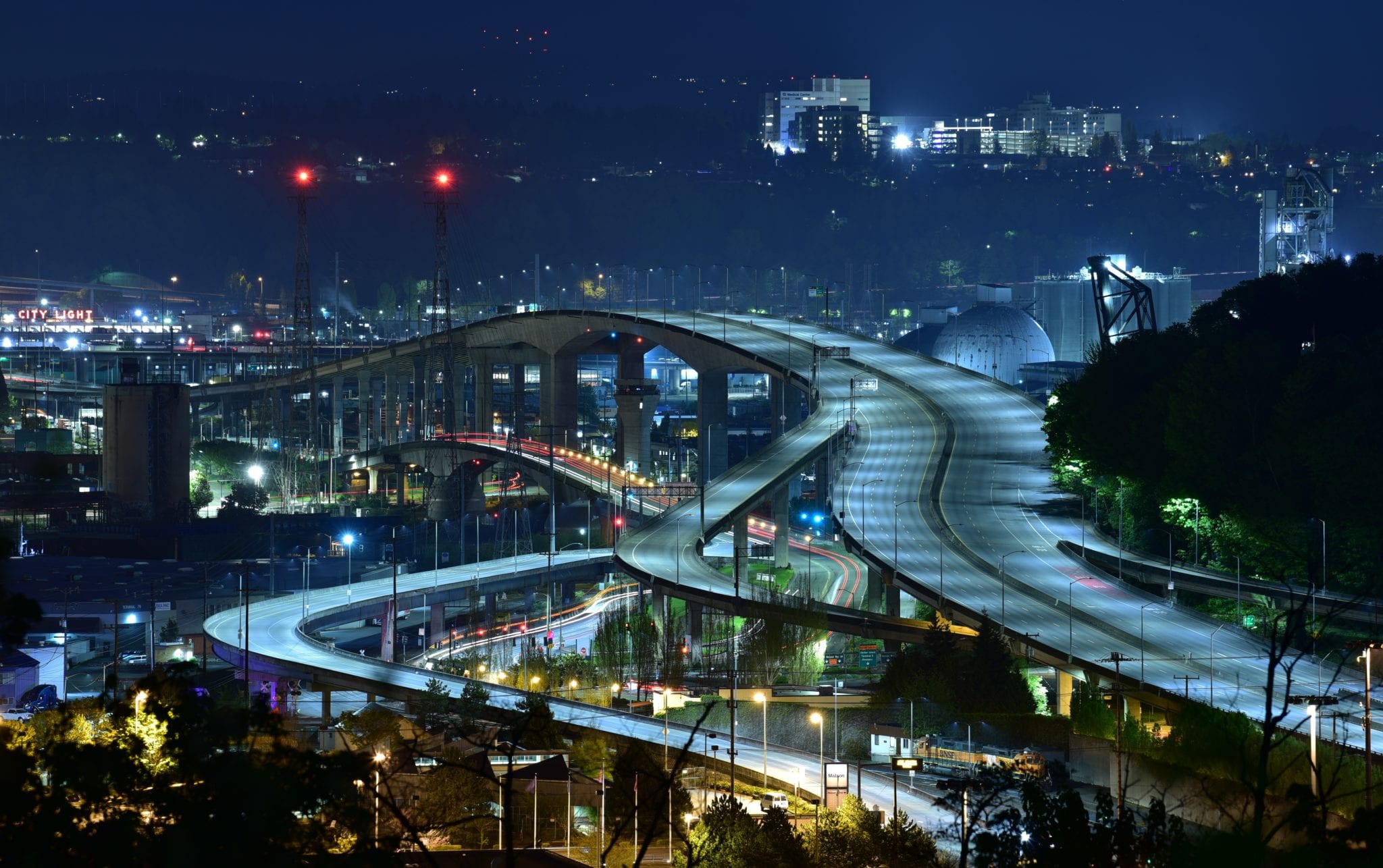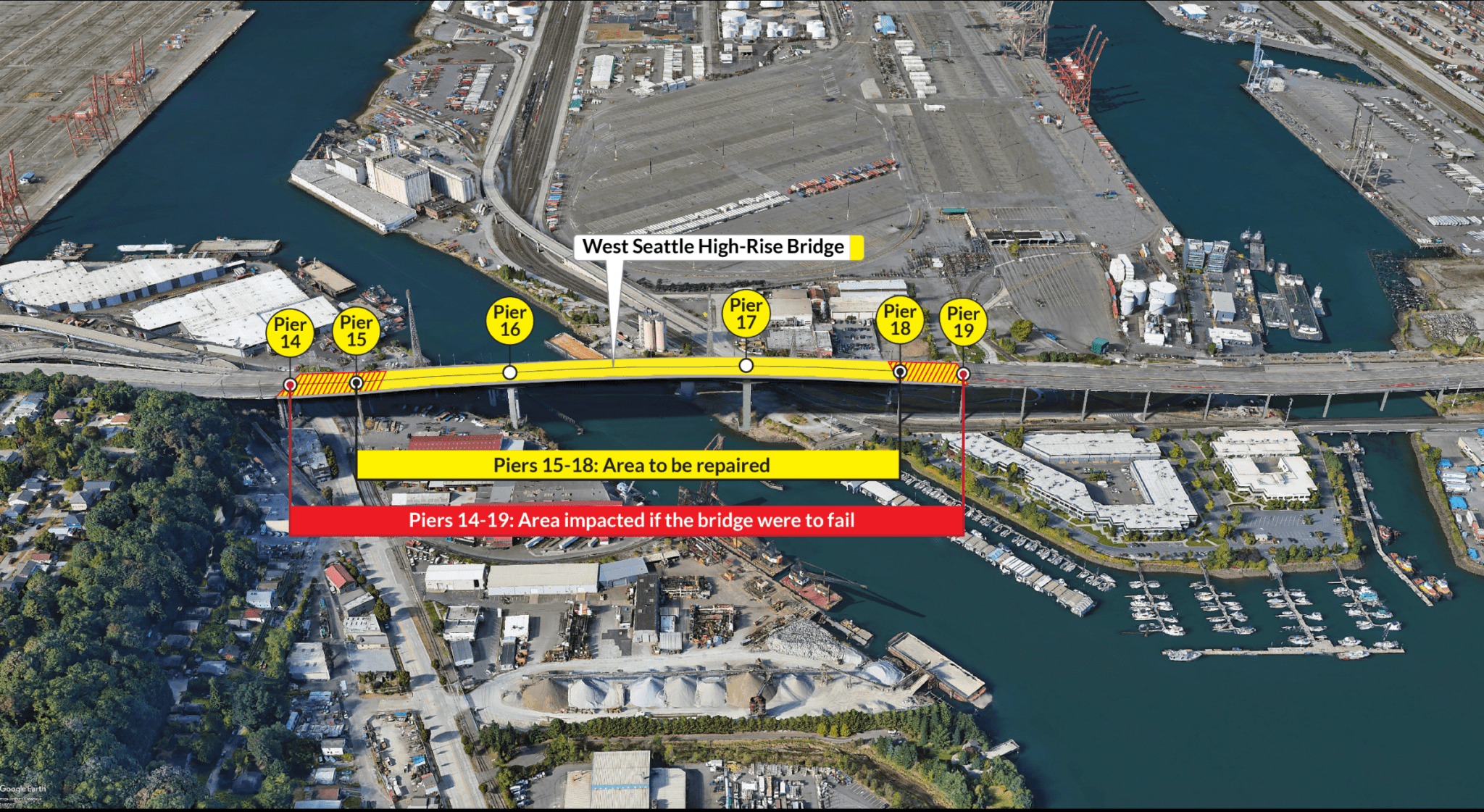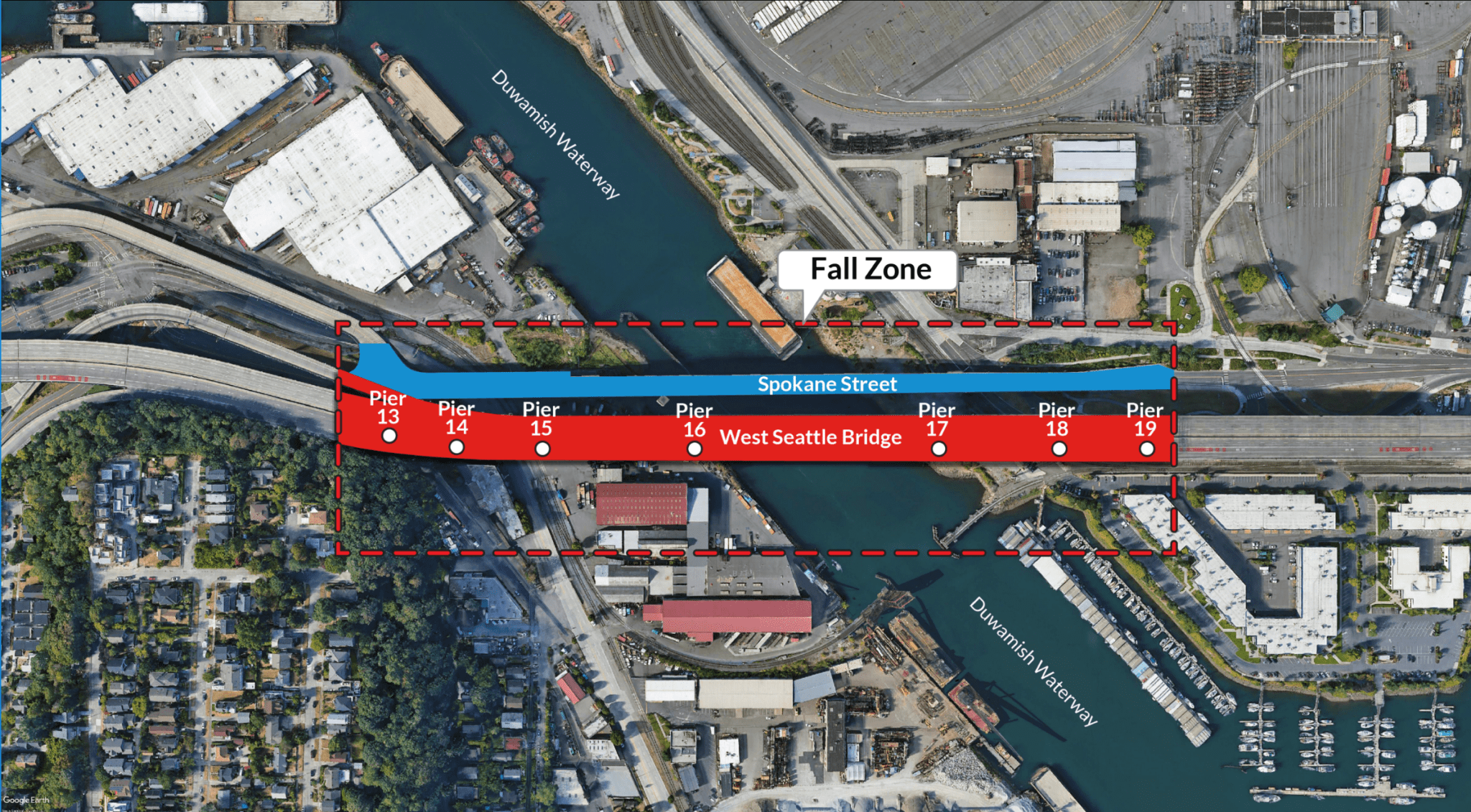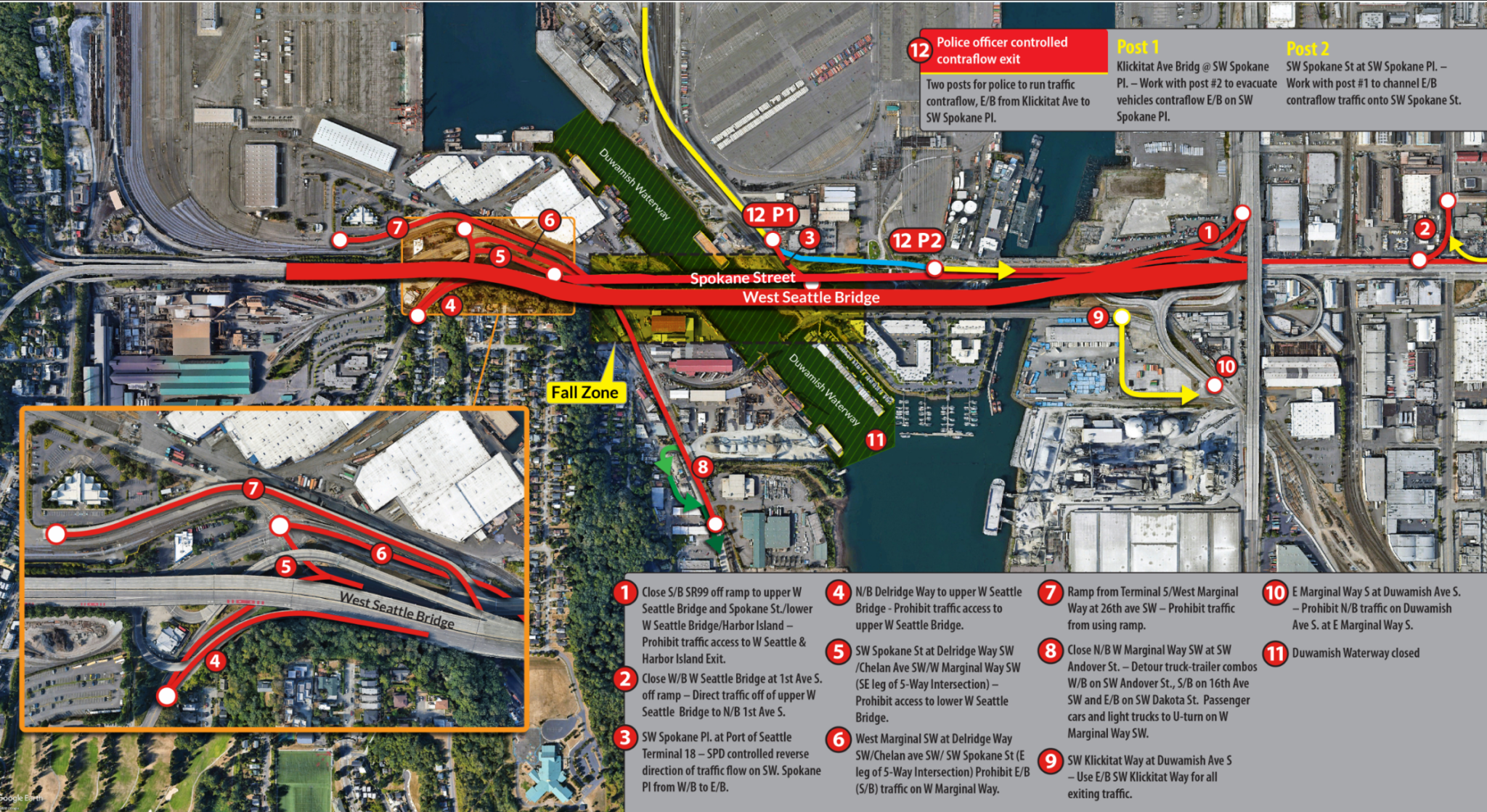 Photo by Chun Kwan.
Photo by Chun Kwan. Graphics updated on 5/4/2020 at 3:50pm
The West Seattle High-Rise Bridge remains stable, and the growth of cracks has slowed since we removed traffic on March 23.
This is, however, an evolving situation. With safety as our number one priority, and out of an abundance of caution, we want everyone to be prepared. We’ve created an emergency response plan that we would like to share with you.
Public safety is our number one priority.
That is why we removed traffic from the West Seattle High-Rise Bridge on March 23, why we are installing a new intelligent monitoring system so we can track the bridge in real time, why we plan to replace lateral bearings on Pier 18, and why we recently shared with you the initial outlines of our safety management plan. That is also why we’re encouraging everyone in Seattle, including our maritime community who transit the Duwamish Waterway, to sign up for AlertSeattle notifications.
AlertSeattle is the official emergency notification system used by the City of Seattle to communicate with city residents during emergencies and is a primary way we will communicate any West Seattle Bridge-related alerts to the community. AlertSeattle is an opt-in service that you must sign up for to receive important notifications. Sign up at alert.seattle.gov to receive free alerts from the City via text message, email, voice message, or social media.
After working carefully with a range of stakeholders, we’ve prepared a comprehensive emergency response plan in case there is ever an indication that people in the area surrounding the high-rise section of the bridge are at risk.
There is currently no indication that we would have to implement our emergency response plan, and we hope that we don’t have to, but if we do, we want you to be just as prepared as we are. While we and our partners are working around the clock to preserve public safety, we also want to share actions you should take to be as safe and ready as possible should the bridge rapidly accelerate toward failure before we’re able to implement our stabilization and shoring work.
We’ve established an interagency task force to coordinate a unified emergency response if conditions of the high bridge reach critical thresholds.
The task force includes the City of Seattle, King County, Washington State, Port of Seattle, Northwest Seaport Alliance, United States Coast Guard (USCG), and the US Army Corps of Engineers.
If we must activate the task force’s unified emergency response, a unified command will be led by the Seattle Fire Department (SFD), the Seattle Department of Transportation (SDOT), the Seattle Police Department (SPD), and USCG.
These and other agencies will work together to prioritize public safety and provide clear communication. SDOT will manage traffic operations to assist emergency response and provide consistent updates to the public. SFD will manage evacuation and, if necessary, rescue of people near the bridge. SPD will manage traffic control and assist with evacuation. USCG will manage maritime coordination and communication. Seattle Public Utilities and Seattle City Light will manage utilities to reduce impact on customers.

The only section of the West Seattle High-Rise Bridge that currently has cracks is the highest span directly over the Duwamish River between West Seattle and Harbor Island.
When many people think “West Seattle Bridge”, they picture the entire road between the I-5 off ramp and the traffic light at 35th Ave SW. Of that entire stretch, we are only concerned about the small, yet tall, section that crosses the Duwamish River between West Seattle and Harbor Island. The rest of the bridge is relatively stable and doesn’t currently show signs of distress.
Again, there are currently no indications that we will need to put our emergency response plan into action.
However, we are continually monitoring the bridge, both in-person and remotely, and have planned responses for three scenarios.
- Immediate evacuation to be used if the daily in-person inspections indicates enough of a change to warrant the immediate evacuation of a small number of properties (details shared below), though we could have hours or days before actual bridge failure.
- One to five days notice to be used if the new remote monitoring instrumentation, which will be fully functioning in mid May, indicates enough of a change to warrant execution of evacuation plans within one to five days. If failure is anticipated, but not immediate, SFD and SPD will clearly communicate, via direct site visits and other platforms, when evacuation must occur.
- Controlled demolition to be used if the change in the condition of the high bridge indicates the need for execution of an evacuation plan followed by a controlled demolition.

If changes in the bridge indicate a need to activate our emergency response plan, the only area that will be evacuated are a small number of parcels in the “Fall Zone”, outlined in the image above.
The perimeters of the Fall Zone were determined by modeling potential cracking scenarios and, out of an abundance of caution, adding an additional 75’ buffer. The area spans 225’ north and south of the bridge, 225’ west of Pier 15, and 225’ east of Pier 18, and includes the Spokane Street Low Bridge, parts of Harbor Island, the Duwamish Waterway, and areas on and around West Marginal Way.
While the Fall Zone is the only area that must be evacuated, those who live or work on Harbor Island should be aware that emergency response activity may limit travel to and from the Island.
It is recommended that people on Harbor Island who are non-essential leave the island using the eastern approaches if they receive any notification that the West Seattle High-Rise Bridge is at risk. Those staying should know that emergency response could potentially block vehicle access to the island.
SDOT and other interagency partners have already done outreach to the parcels in the Fall Zone and we are working closely with the Port of Seattle to provide continuous updates.
There are no residential homes in the Fall Zone that would need to be evacuated. People in nearby neighborhoods, including Pigeon Point, can remain home.

Should we need to activate our emergency response plan, Seattle police and fire departments will close access to roads near the Fall Zone.
In this situation, everyone should avoid the surrounding area to prioritize emergency access. Following the map above, Seattle Police will be onsite to stop and direct traffic away from the Fall Zone.
We will use multiple communication methods to get evacuation messages out to people in the impacted area, and beyond.
- AlertSeattle text message, email, and voice message – sign up today! AlertSeattle is the official emergency notification system used by the City of Seattle to communicate with city residents during emergencies. If an evacuation is necessary, the City will use AlertSeattle to notify everyone in our database to stay away from the area in order to prioritize emergency access.
- Wireless Emergency Alert (WEA) text messages. WEA is an alert system that sends text messages to all cell phones within a particular area. This is the same service that sends Amber Alerts. WEA will send text message alerts to all cell phones in the impacted area at the time of alert. Note, if you are often in the area, but you, or your cell phone, aren’t present in the area at the time the WEA alert is sent, you will not receive the text message. This is why we encourage everyone to sign up for AlertSeattle messages.
- United States Coast Guard (USCG) alerts. The USCG will send an Urgent Marine Information Broadcast over VHF Channel 16 to warn mariners to avoid the Duwamish Waterway, and they will use the USCG Alert Warning System to warn commercial operators and terminals on Harbor Island and the Duwamish Waterway.
- Twitter, Facebook, SDOT Blog, and website. In the case of a West Seattle High-Rise Bridge emergency, SDOT will provide regular updates on Twitter, Facebook, and our website.
Sign up to receive West Seattle High-Rise Bridge project update emails.
Visit our West Seattle High-Rise Bridge website to sign up for periodic emails to stay up-to-date on the bridge. On the website you will also be able to see frequently asked questions, view inspection reports, and find links to our West Seattle Bridge blogs.
If you have specific questions, contact us at Road@seattle.gov or 206.684.ROAD (206-684-7623).